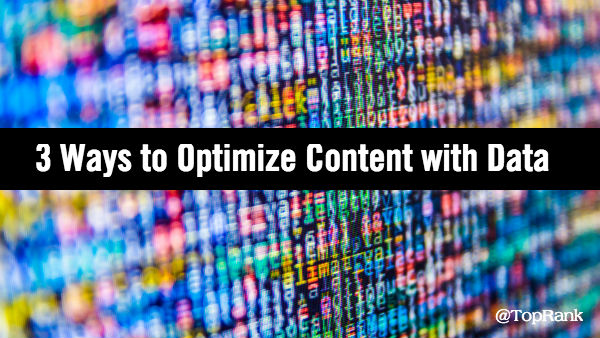
In 1984, a person saw an average 2,000 ads/day. By 2014, they saw around 5,000. (Media Dynamics)
There’s some irony to the fact that it’s due to data and information overload that consumers face on a daily basis (63gb of media per day in the US according to USC/ICT) that data has become even more important for marketers.
Successful marketing today isn’t just about creating useful content that informs buyers, it must be even easier to find in all the right places and deliver both utility and experience. Without data insights about customer preferences, it’s very difficult to deliver on that.
“Understanding how to use data to drive to the right client conversations has become the most powerful weapon in a marketer’s toolkit. Using different types of data – intent data, behavioral data, purchase data – is key to driving engagement and building a demand funnel. We use data for early stage engagement to inform our content marketing editorial calendar and campaign strategy and also to build buyer journeys by successfully converting inquires into sales conversations.”
Tami Cannizzaro – Vice President, Head of North America Marketing and Global Digital Demand Centers, CA Technologies
As for tailoring data, there are a number of factors that guide how much or little, how sophisticated or basic an approach needs to be. As an agency that primarily creates content to help B2B companies create awareness, improve engagement and drive leads/sales, our customer empathy model focuses on optimizing the relationship that prospective customers have with information during the buyer journey.
In particular, there are three key opportunities for data informed customer empathy and you can go as light or as deep as necessary. Those opportunities for optimization include:
- Discovery – where do buyers discover resource and solution information – search, social, ads, publications, influeners and influences
- Consumption – what are buyers preferences for content topics and types as well as devices. what experience do they expect?
- Action – what are the intellectual and emotional triggers that will motivate them to take the next step in the journey
When brands have customer segments and even personas sorted out, you can get as specific and sophisticated as you like. If not, then it’s often more practical to phase in your approach and get deeper as you learn and complete your understanding of buyers as they discover, engage and take action with your content.
There are many ways to get started with data-informed content, including these 5 tips from Anne Leuman. Additionally, here are three high level considerations including industry research and benchmarking, private brand data and competitive data to help optimize your content marketing performance.
Industry Data for Benchmarking – One of the starting points for the use of data for improved customer engagement with content is to benchmark. Industry centric research can be useful to provide that kind of data to highlight trends and a baseline against which to guage campaign or marketing program performance. Here are a few examples:
- Industry stats to recommend tactics. For example, to justify content marketing, a company might rely on industry research:
– Content marketing generates over three times as many leads as outbound marketing and costs 62% less.
– After reading recommendations on a blog, 61% of U.S. online consumers made a purchase. - Industry average performance metrics can also be directional benchmarks – open rate, conversion rate, cost per lead, etc can point you in a particular direction or help create some validity towards a hypothesized goal. That said, be careful about treating industry averages as universal truths since it is your own market, customers and content metrics that you’ll want to rely on most.
- Industry data can provide a benchmark against brand data – Companies often want to create comparisons and will use industry averages of things like conversion rates and cost per lead to do so. Closing the gaps between brand performance and an industry average is what can drive initial performance optimization.
- Benchmarks aid in content planning – Research about common issues in a particular industry can help identify key problems to be solved for the customer and the narratives that can drive the brand’s position as a solution to those problems.
Private Data for Opportunities and Performance Optimization – While industry level research and reports represent the macro view, analytics from a brand’s own website, marketing programs, search and social media could be considered the micro view. But what kind of brand data can be useful? A few examples of brand data sources:
- Google Analytics and other web analytics data are probably the most frequently used sources of insight for content performance optimization. Conversion reports to page reports can help identify what is working and what is not.
- Buzzsumo social share data of your website URLs overlaid on search performance can be insightful.
- PPC campaign data such as from Google AdWords.
- Google search console data where you can find numerous opportunities to optimize content for better search performance.
- Social analytics from monitoring tools like Brandwatch, Linkfluence (client), or more basic tools like SproutSocial.
- Search Marketing insights from platforms like SEMrush, Majestic and Moz.
- CRM data including everything from open rates, traffic, landing page conversions, what percent of leads are qualified, the sources of those leads. Platforms range from HubSpot to Marketo to ESPs like Adestra.
- RivalIQ – The emphasis is on comparing your own social and search data to competitors with robust trending reports and alerts for spikes that can help identify opportunities in the short and long term.
Challenges with brand data. Working with internal data is not without its challenges. Not every company’s IT or analytics department is willing to provide access or there are data privacy and security protocols in place that make accessing this kind of data difficult. To get access, it’s important to have a compelling use case and executive sponsorship. Also be sure to share what’s in it for IT if they provide access.
Another challenge can be the sheer volume of data, especially from large enterprise companies with robust marketing programs that may or may not be well organized. Aggregating and organizing that data from disparate marketing technology platforms and analytics applications can be a project all on its own.
The key is to have specific goals for the use of the data tied to a business case or marketing outcome. Your informed hypothesis about how to grow company revenue can open doors to the information that can inform exactly what kinds of opportunities you can leverage to make that hypothesis a reality.
Competitive Research Data – An important opportunity to use data for more informed and optimized content marketing is competitive research. Looking at other companies in your industry can provide a useful point of comparison when your company is implementing something new or if you’re a challenger brand working to move into a leadership position in the marketplace.
Here are a few types of competitive comparisons that can be useful:
- Broad based comparisons on things like share of voice, overall footprint, share of topic, share of influence, and comparison of advertisements. These kinds of comparisons help answer what the brand is up against and where the weaknesses and strengths for opportunities are.
- For SEO – Competitive research on search data helps to understand the share of search in a category and where the opportunities are for keywords/topics that represent an ideal ratio of competitiveness to demand. In highly competitive categories with established, deep pocket competitors, it often pays off to target a larger mix of less popular, but highly relevant and actionable keyword clusters to drive end of funnel ROI.
- For social media – Monitoring when competitors get spiked social activity to learn from – also to see what not to do.
You can also use competitor data to find what we call “white space” – topics where the conversation isn’t saturated yet but is still highly relevant with opportunities.
For example, our work with a client that provides Field Service Management software found their market pretty saturated with content on that topic. What they saw as an opportunity was to focus on a new expression that represented a key attribute that was important to their customers.
The result of finding the niche “white space”? A single campaign focused on creating awareness and demand around the idea of “field service engagement” including an authoritative ebook, blog posts and an industry influencer resulted in $1.5m in sales pipeline.
Data is abundant and with ubiquitous connectivity and proliferation of data creating devices, there will be no shortage of data for marketers to use. The key questions to answer are about what brands hope to achieve, what kind of data they have access to and what resources are available to collect the data, analyze for insight and then use that data to execute an improved or optimized content marketing program.
For even more insights on leveraging data for marketing, listen in to this conversation I had with Seth Bridges from RivalIQ.


